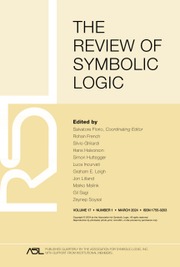No CrossRef data available.
Article contents
THE BOUNDED FRAGMENT AND HYBRID LOGIC WITH POLYADIC MODALITIES
Published online by Cambridge University Press: 22 March 2010
Abstract
We show that the bounded fragment of first-order logic and the hybrid language with ‘downarrow’ and ‘at’ operators are equally expressive even with polyadic modalities, but that their ‘positive’ fragments are equally expressive only for unary modalities.
- Type
- Research Article
- Information
- Copyright
- Copyright © Association for Symbolic Logic 2010
References
BIBLIOGRAPHY
Areces, C., Blackburn, P., & Marx, M. (2001). Hybrid logics: Characterization, interpolation, and complexity. Journal of Symbolic Logic, 66, 977–1010.CrossRefGoogle Scholar
Feferman, S. (1968). Persistent and invariant formulas for outer extensions. Compositio Mathematica, 20, 29–52.Google Scholar
Feferman, S., & Kreisel, G. (1966). Persistent and invariant formulas relative to theories of higher order. Bulletin of the American Mathematical Society, 72, 480–485.CrossRefGoogle Scholar
Goldblatt, R. (1995). Elementary generation and canonicity for varieties of boolean algebras with operators. Algebra Universalis, 34, 551–607.CrossRefGoogle Scholar
Hodkinson, I. (2006). Hybrid formulas and elementarily generated modal logics. Notre Dame Journal of Formal Logic, 47, 443–478.CrossRefGoogle Scholar
ten Cate, B. (2005). Model theory for extended modal languages. PhD Thesis, University of Amsterdam.Google Scholar
ten Cate, B., & Franceschet, M. (2005). On the complexity of hybrid logics with binders. In Ong, L., editor, Proceedings of Computer Science Logic 2005, Volume 3634 of Lecture Notes in Computer Science, pp. 339–354. Berlin/Heidelberg, Germany: Springer Verlag.Google Scholar


